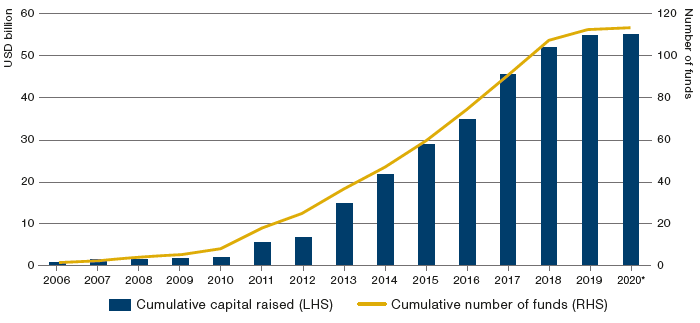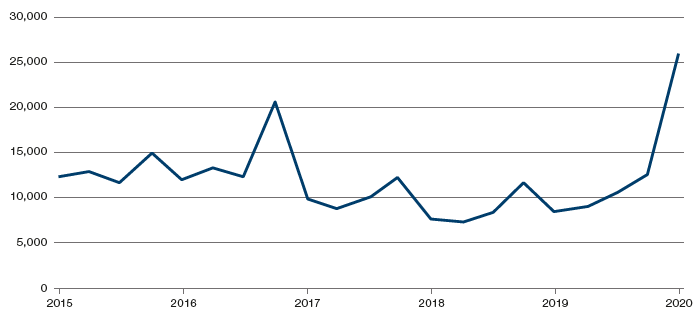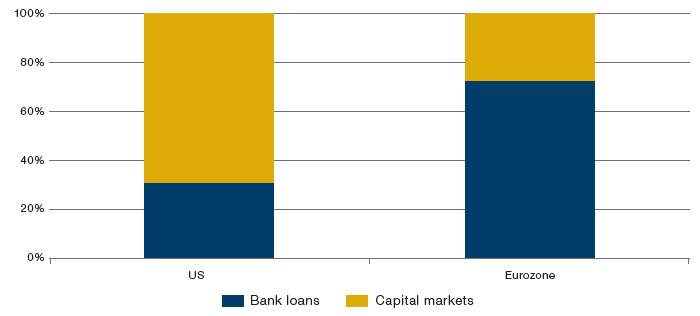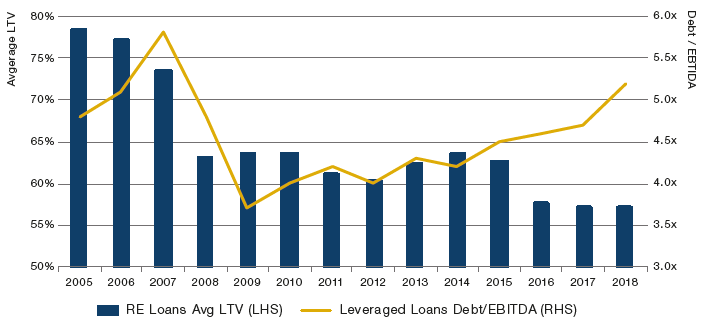1. Introduction
Real estate loan investment strategies have attracted significant investor interest over the last few years due to the yield premium relative to corporate bonds and their potential to mitigate downside risk relative to real-estate equity. This article discusses real estate debt in general, and specifically in Europe, as well as the considerations investors should keep in mind when looking to invest in real-estate debt.
In our view, the current landscape has been shaped by two factors – the withdrawal of bank lending after the Global Financial Crisis (‘GFC’), and the onset of the coronavirus pandemic of 2020. These present opportunities as well as challenges. If investors are prepared to adjust their portfolios to take advantage of the consequential structural shifts in property markets, whilst maintaining a pre-eminent position within the capital stack, they may well find themselves in a strong position – without meaningful competition from bank lenders, and able to demand better pricing and covenants.
2. Commercial Real Estate Debt Since the GFC
Since the GFC, banks have generally pared back real estate lending activities. This move has been driven by a combination of regulatory interventions designed to rein in their risk appetite:
- Greater and more active regulatory oversight has been focussed around banks’ overall exposure to real estate; and
- The implementation of Basel III and – to an even greater extent – Basel IV (as will be implemented over the next few years) has increased bank regulatory capital requirements for lending to real estate, particularly at higher loan-to-value (‘LTV’) levels.
Real estate loans represented almost 12% of total loans on the balance sheets of all banks resident in the UK in 2009. In Portugal, the figure was more than 12%, in Italy it was about 9%. Banks have since rationalised their lending activities to the real estate sector.1 Net lending to real estate was negative for most of the period between 2009 and mid-2015.
This has resulted in commercial real-estate borrowers now regularly turning to non-bank lenders, such as specialist debt funds, for financing. As such, commercial real estate loans have attracted significant investor interest in the last several years (Figure 1).
Figure 1. European Real Estate Debt Fundraising

Source: Preqin; as of 4 March 2020.
One can reasonably expect the economic disruption caused by the Covid-19 pandemic to result in a further retrenchment by banks, manifested both in higher pricing and more conservative risk underwriting. Through the second quarter of 2020, banks in the Stoxx Europe 600 have taken Covid-19 related provisions for loan losses of EUR16.5 billion according to data from Bloomberg. Figure 2 below shows a marked increase in provisions for loan losses since the beginning of 2020. The knock-on effect is likely to be a reduction in bank lending2 which increases the opportunities for non-bank lenders; unlike in the US, where corporate borrowers rely more heavily on capital markets, European companies get the majority of their funding from bank loans (Figure 3).
Figure 2. Stoxx Europe 600 – Quarterly Provisions for Loan Losses (EUR billion)

Source: Bloomberg; as of 31 March 2020.
Figure 3. Corporate Financing Sources

Source: Deutsche Bank “How to Fix European Banking”; as of March 2019.
3. Investing in Commercial Real Estate Debt
In our view, there are three main reason why institutional investors should consider commercial real-estate loans:
- Commercial real-estate loan returns have been more attractive than those in traditional fixed income markets3 (where returns are at or near all-time lows);
- We believe these investments have the potential to mitigate some risk in the event of a fall in real-estate values;
- The commercial real-estate debt market is more conservative and disciplined in 2020 relative to before the GFC, and also when compared with other private debt markets.
3.1 Returns
The various real estate debt investment strategies target a range of risk-return profiles, including: senior loans, whole loans and mezzanine loans. Each attempts to fill a gap in the market created by the withdrawal of banks. Each has generated a return in excess of that which is available from public market securities with similar risk profiles, mainly due to: (a) sourcing and execution complexity; and (b) illiquidity (Figure 4).
Senior loan investments target first mortgage secured loans with a portfolio average LTV of about 60%. Whole loan investments are also secured by first mortgages but target a slightly higher LTV below 70%. Subordinated or mezzanine investments are structurally subordinate to a first mortgage and target loans with higher LTV ratios (75-80% on average) but generate higher returns.
Figure 4. Commercial Real Estate Loans – Returns

Source: Bank of America Merrill Lynch, Cass Commercial Real Estate Lending Survey; as of 30 June 2019.
A common feature of all three strategies is the regular (typically quarterly) distribution of interest income (the annual yield). Other real estate debt investment strategies – such as distressed, special situations or construction loans – are typically focused on total return and not the annual yield as the loans do not generate current income.
3.2. Downside Risk Mitigation
The degree of downside-risk mitigation changes in relation to the different strategies considered above. The risks associated with senior loans and whole loans are similar. Both invest in loans which are secured by a first mortgage. The lender in both cases is in a position to control the outcome in a downside scenario. Furthermore, senior loans and whole loans are underwritten at LTV levels which protect the investor’s principal if collateral values fall 30-40%, a fall which would equal the most significant decline in European real estate values in the last 40 years.4
Subordinated loans, on the other hand, are exposed to higher risk than first mortgage loans. If the property cash flow or value falls, the subordinated lender must ensure that the first mortgage loan does not default. In addition, the subordinated lender may be required to repay the first mortgage loan in full, or risk losing the entire investment. A first mortgage loan cannot suffer a 100% loss unless the value of the collateral is zero.
3.3. Market Discipline
Prior to 2008, lenders provided loans at levels approaching 80% (indeed, as high as 90% in some markets like Germany) of underlying real estate values (Figure 5). In comparison, the average LTV requirement for senior loans in Europe is now around 57% of underlying real estate values, according to Cushman and Wakefield. The lower LTV ratios at which loans are offered today is a direct result of higher regulatory capital requirements and enhanced regulatory oversight of bank real estate lending activities in Europe.
This contrasts favourably with other private debt markets, where leverage is increasing. Figure 5 compares average LTVs for real estate loans with average debt-to-EBITDA5 ratios for loans in the corporate leveraged loan market. European leveraged loan debt-to-EBITDA ratios have increased significantly to levels approaching those last seen in the run-up to the GFC. European real estate LTV ratios, on the other hand, have not increased.
Figure 5. Real Estate Loans Versus Corporate Leveraged Loans

Source: Cass Business School 2018 Commercial Property lending Report (Average LTVs), and Duff & Phelps, April 2019.
Furthermore, financial covenants have deteriorated substantially in several private loan markets. The deterioration in the lender protections in the leveraged loan market, for example, has been well publicised: at the end of 2018, 87% of leveraged loans in Europe6 were covenant-lite.
European real estate loans usually contain covenants which test both property value and cash flow. Often, there will be a level at which all cash flow is trapped by the lender as additional collateral, and another level at which the loan is in default. The example in Figure 6 assumes a loan of EUR65 million secured by real estate with a value of EUR100 million (65% LTV). If the value falls by 13% to EUR86 million, all excess cash flow after debt service is trapped as additional collateral for the loan. If the value falls a further 10% to EUR76 million, the loan will be in default.
Figure 6. Example of Typical LTV Covenants in a European Real Estate Loan

Source: Man GPM. For illustrative purposes.
In the example above, the covenants are breached well before the value of the real estate has fallen below the amount of the loan. This ‘early warning system’ provides the lender with the ability to execute a risk mitigation strategy before it incurs a loss. In our experience, financial covenants are very valuable in a downturn.
4. Challenges of Investing in Commercial Real Estate Debt
The first challenge of investing in European real estate debt is assessing the probability of deterioration in underlying real estate asset values and economic conditions. As an example, the uncertainty around geopolitical events (such as the coronavirus or Brexit) or economic performance can make underwriting real estate values and cash flows in some countries more difficult.
Second, real estate transactions (e.g. sales and leases) are generally privately negotiated and, as a result, information around real estate markets is not always publicly available. Substantial due diligence often involving an extensive network of market participants is required to provide transparency around real estate market dynamics.
We believe a way to mitigate these risks is by focusing on real estate loans secured by first mortgages as opposed to mezzanine loans, as these provide strong risk mitigation and structural protection should underlying real estate asset values decline. In addition, diversification across different borrowers, asset types and geographies can decrease idiosyncratic market risk.
5. Considerations for Investors in a Coronavirus World
We believe the areas of the market currently underserved by banks offer the most interesting investment opportunities. Banks tend to focus on lower leverage lending (generally less than 60% LTV, depending on the market). Further, the market for middle-market sized loans (i.e. those between EUR20 million and EUR50 million) tends to be less competitive; large banks are focused on loans larger than EUR50 million, and small banks are focused on loans smaller than EUR20 million. This tendency has been exacerbated by the coronacrisis. Lending competition has dropped further with banks focused on client retention rather than acquisition, with much of this attention going towards their largest clients. New loan pricing is roughly 50-100bp wider than it was prior to March, and LTV ratios offered by non-bank lenders have fallen, a further shift of the market back in favour of those lenders willing to put to capital to work.
Secondly, given the maturity of the current market cycle, we believe that investing in loans secured by a first mortgage on real estate that generates stable income from tenants offers an appealing risk-reward profile. In our view, first mortgage loans will outperform mezzanine loans in a downturn – a key concern during the coronavirus recession. Securing high-quality tenants with stable income streams is easier said than done - both the hotel and retail sectors have experienced significant downturns in cashflow. Land Securities, the largest commercial property developer in the UK, announced in May that 63% of retail tenants paid rent in their most recent rental period, a figure which has likely deteriorated since then. Likewise, whilst the recovery in hotel occupancy may be gradual, valuations are approaching levels which might be attractive over the longer term. Despite these shifts, office, warehouse and residential properties have not seen meaningful changes in rent delinquencies. Consequently, our view is that all three sectors may be able to generate stable income over the short to medium term. If investors are prepared to adjust portfolios to take advantage of structural shifts in property markets, whilst maintaining a pre-eminent position within the capital stack, they may find that the coronacrisis provides more opportunity than anticipated.
Finally, investment decisions must be made on a case-by-case basis after substantial due diligence and scenario analysis to evaluate downside risks. For example, loans secured by retail properties warrant caution in light of increasing competition from online retail platforms. However, there are demographic, location and consumer behaviour patterns and factors which are unaffected by e-commerce and which allow for some bricks-and-mortar retail schemes to exist in parallel.
6. Conclusion
The European real estate debt market has changed dramatically since the GFC, with the coronavirus pandemic likely to exacerbate or, in some cases, accelerate pre-existing trends. The reduction in bank lending activity – constrained by regulatory capital and enhanced oversight – has created a structural opportunity for non-bank lenders to exploit. As such, we believe European commercial real-estate loans represent an appealing asset class for three reasons: firstly, returns have been more attractive than those in traditional fixed income markets (where returns are at or near all-time lows) and have remained so since the onset of the coronavirus pandemic; secondly, these investments have the potential to mitigate downside risk in the event of a fall in real-estate values; and thirdly, the commercial real-estate debt market is much more disciplined than prior to the GFC, and also when compared with other private debt markets.
1. Source: Bank of England, International Monetary Fund, Haver Analytics.
2. IMF Working Paper: The Dynamics of Non-Performing Loans During Banking Crises: A New Database, December 2019.
3. Source: BofA Merrill Lynch (BB and BBB rated EUR corporate 3-5 year asset swap spread), CBRE.
4. Source: CBRE.
5. Earnings before interest, taxes, depreciation and amortisation.
6. Source: S&P Global Market Intelligence.
You are now leaving Man Group’s website
You are leaving Man Group’s website and entering a third-party website that is not controlled, maintained, or monitored by Man Group. Man Group is not responsible for the content or availability of the third-party website. By leaving Man Group’s website, you will be subject to the third-party website’s terms, policies and/or notices, including those related to privacy and security, as applicable.